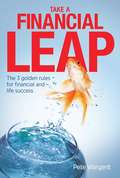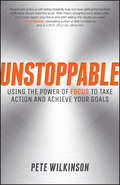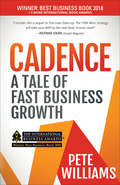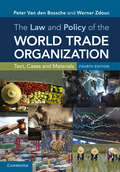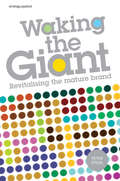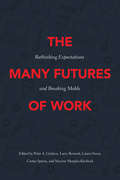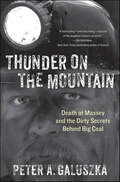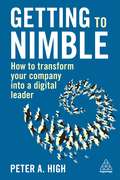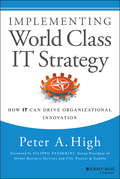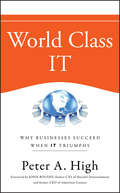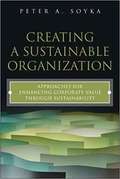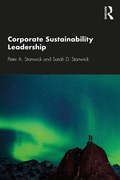- Table View
- List View
Work Stronger: Habits for More Energy, Less Stress, and Higher Performance at Work
by Pete LeibmanAs author and high performance coach Pete Leibman demonstrates in this eye-opening book, stronger hours (not longer hours) are the key to feeling and performing your best over the long term. Work Stronger provides a step-by-step, science-based approach for increasing your energy, decreasing your stress, and taking your performance to a higher level. This book also features practical tips and powerful insights from private interviews that Leibman conducted with more than twenty-five prominent leaders. The group includes Chip Bergh, the president and CEO of Levi Strauss & Co., Dick Costolo, the former CEO of Twitter, and Janine Allis, an investor on Shark Tank. You’ll learn how to form stronger habits in four key areas (nutrition, exercise, focus, and renewal) that are highly correlated with greater health, well-being, and performance. You can also get a free assessment of your current habits, and you can download a free copy of The Work Stronger Workbook at WorkStronger.com.
Oracle BAM 11gR1 Handbook
by Pete Wang"Oracle BAM 11gR1 Handbook" is a practical best practices tutorial focused entirely on Oracle Business Activity Monitoring. An intermediate-to-advanced guide, step-by-step instructions and an accompanying demo project will help SOA report developers through application development and producing dashboards and reports. If you are a developer/report developer or SOA Architect who wants to learn valuable Oracle BAM best practices for monitoring your operations in real time, then "Oracle BAM 11gR1 Handbook" is for you. Administrators will also find the book useful. You should already be comfortable with SOA architecture and SQL practices.
Four Green Houses and a Red Hotel: New strategies for creating wealth through property
by Pete WargentFour Green Houses, and a Red Hotel provides new and experienced investors with a specific state by state guide to the best property investments for future wealth. Successful investment often mirrors a game of Monopoly – winners keep their expenses low and continue to acquire prime investments over time. Financial expert and author Pete Wargent, provides simple and effective strategies for acquiring wealth through property and a holistic financial plan, which includes share investment. The economic instability since the financial crisis and the volatility of investment markets have made investment a daunting prospect for many Australians. With interest rates cut to record lows, consumer confidence is growing and investors are coming back to the market in droves; albeit with a thirst for information on new property strategies and markets. Four Green Houses, and a Red Hotel is an up-to-date look at each of the capital cities in Australia and the best investments in property and shares in each state.
Get a Financial Grip: A simple plan for financial freedom (Big Sky Publishing Ser.)
by Pete WargentPete Wargent used shares, index funds and investment property to become a millionaire at the age of 33 and quit fulltime work. His new book is a detailed plan for achieving financial freedom at any age by taking control of your finances and implementing a holistic financial strategy. The global financial crisis has seen us living through times of great volatility and uncertainty. Many people have been forced to endure periods of unemployment, housing has become almost unaffordable and it seems that the concept of a job for life is a thing of the past. It is more important than ever that we create a sustainable lifestyle and have a financial plan that is not totally reliant on a job and a salary. Get a Financial Grip looks at the psychology and mindset of success as well as looking at the asset classes that can be used to attain the leverage and returns to achieve financial goals. The author presents a comprehensive, but easy to understand plan for building and balancing a portfolio for generating wealth through compound growth. It shows how your money can work for you and give you the best odds of breaking the link between work and income. This is not just another text on financial and investment theory, it is a practical, specific and life-changing plan to propel your finances to a level you may never have believed possible. It&’s a simple plan for achieving financial freedom; offering you the chance to live the life you choose.
Take a Financial Leap: The 3 golden rules for financial life success
by Pete WargentAn inspirational and motivating book that shows how three &‘&’golden rules&’&’ can be used to accelerate results and set exciting and inspiring goals – not only when investing in property or shares, but also in business and all areas of life. Much more than just another investment book, Take a Financial Leap looks at the psychology of success and how by simply mastering three easy rules, the results readers can achieve are almost limitless. Pete Wargent, a successful financial commentator, investor and author, has written an easy to read and understand guide, using lots of practical case studies and personal stories to show readers how to:Set big, exciting and inspiring goalsUse compound growth and &‘&’snow-balling&” to generate wealthUnderstand the psychology of success and how to achieve emotional masteryLearn how to become a long-term, successful share market investorCreate substantial and lasting wealth through real estateBuild a successful business or career in the field of their passionEscape the rat race and live the life they chose, rather than one dictated to them by a pay cheque. This book is a detailed plan for accelerating success and achieving financial freedom and success at any age across all aspects of life. It is a practical and motivating book that uses 3 simple rules to provide a road-map for taking finance and life goals to the next level.
Unstoppable
by Pete WilkinsonBE DETERMINED. BE DRIVEN. BE UNSTOPPABLE.Don't just coast through life - power through. Stop making plans that don't come to fruition. Everyone's busy, but nobody's getting much done. It's time to start achieving our life goals and not letting life itself get in the way.GET ORGANIZED. LEAD. BUILD RELATIONSHIPS. DELIVER RESULTS.With training from accomplished business coach and endurance triathlete Pete Wilkinson, you'll learn how to hone a razor sharp focus, keep driving through to the finishing line and become what you've always wanted to be. You'll learn how to be more productive, expand your support system, and make things happen. You'll discover your strengths and weaknesses, and how to leverage one and delegate the other. With a practical, straightforward action plan for life, Unstoppable will help you:Gain a crystal-clear overall focusDirect your attention to key areas of priorityLead yourself and others more effectivelyMake the most of each day's 86,400 secondsImprove personal and professional relationshipsSo, dust off your aspirations and drag them into the light. Get rid of the frustration, regain your focus, and start making your goals a priority. Unstoppable gives you a roadmap to your very best destination.
Cadence: A Tale of Fast Business Growth
by Pete WilliamsCadence is a parable of a business owner and triathlon coach named JJ who left his stable job as a teacher to fulfill his dream of becoming an entrepreneur. Unfortunately, two years after opening his bike shop, JJ finds himself in a place that is all too familiar to most business owners—struggling to stay afloat. That all changes, fast, when an athlete he coaches teaches him how to turn the store’s profitability around with seven key “10% Wins.” Cadence uniquely communicates entrepreneur and advisor Pete Williams’s “7 Levers” approach to business growth through the vehicle of a story. Instead of offering a list of do’s and don’ts for business success, Cadence imparts wisdom by inviting readers on a journey into the lives of two characters who each have something valuable to teach the other. Through the use of down-to-earth dialogue and realistic business challenges, readers will immediately be pulled into the story of JJ and Charlie, and how they each learn to hit their stride and turn profitability around.
The Law and Policy of the World Trade Organization: Text, Cases and Materials
by Peter Werner Zdouc Van Den BosscheSince its first edition, this textbook has been the first choice of teachers and students alike, due to its clear introduction to the basic principles of the multilateral trading system and its detailed examination of the law of the World Trade Organization. The third edition continues to explore the institutional and substantive law of the WTO. Material has been restructured to closely align with teaching approaches making it even more user-friendly. It has been updated to incorporate all new developments in the WTO's body of case law. Questions and assignments are integrated to allow students to assess their understanding, while chapter summaries reinforce learning. Chapters end with an exercise reflecting real-life trade problems: these challenge students (and practitioners) and enable them to hone their analytical skills. This title is an essential tool for all WTO law students and will also serve as the practitioner's introductory guide to the WTO.
Waking the Giant
by Peter SteidlBrand maturity is not inevitable. Waking the Giant challenges current thinking and practice when it comes to achieving growth with mature brands. This book convincingly demonstrates that the challenge of revitalising a mature brand is just as exciting -- and requires just as much ingenuity and innovation -- as launching a new brand. While major mature brands still dominate many categories, margins and growth opportunities are often less than exciting. The critical question is: milk the brand, or revitalise? And, just as important: is your organisation fully committed to, and able to deliver on, your chosen strategy? Inside you'll discover: the merits of revitalisation and milking strategies, and how to choose between them how to renew positive differentiation for a mature brand how to implement a revitalisation strategy and eliminate outdated work practices that could ruin your plan how to align your revitalisation strategy with the consumers' and industry sector's evolutionary trends.
Human Resource Strategy: Formulation, Implementation, and Impact
by Peter A. Bamberger Professor Ilan MeshoulamHuman Resource Strategy provides an overview of the academic and practitioner responses to these and other questions. Applying an integrative framework, the authors review twenty years' worth of empirical and theoretical research in an attempt to reconcile often-conflicting conceptual models and competing empirical results. The authors present much of the relevant research in the context of the critical strategic decisions that executives must actually make with regard to human resource investments and deployments. As a result, often complex theoretical models and scientific findings are presented such that they are not only understandable but also highly relevant to non-research-oriented practitioners.
Cork'd: Building a Social Network for Wine Lovers
by Peter A. ColesLindsay Ronga and Gary Vaynerchuk are launching Cork'd, an online social network for wine lovers. Despite Gary's status as a celebrity wine connoisseur, the team faces a significant challenge: several other wine social networks are well established and already have large user bases. How can Cork'd gain traction in this crowded space?
The Many Futures of Work: Rethinking Expectations and Breaking Molds
by Peter A. Creticos, Larry Bennett, Laura Owen, Costas Spirou, And Maxine Morphis-RiesbeckWhat will work eventually look like? This is the question at the heart of this timely collection. The editors and contributors—a mix of policy experts, academics, and advocates—seek to reframe the typical projections of the “future” of work. They examine the impact of structural racism on work, the loss of family‑sustaining jobs, the new role of gig work, growing economic inequality, barriers to rewarding employment such as age, gender, disability, and immigration status, and the business policies driving these ongoing challenges. Together the essays present varied and practical insights into both U.S. and global trends, discuss the role of labor activism in furthering economic justice, and examine progressive strategies to improve the experience of work, wages, and the lives of workers. The Many Futures of Work offers a range of viable policies and practices that can promote rewarding employment and steer our course away from low-wage, unstable jobs toward jobs that lead to equitable prosperity and economic inclusion.
Saving Social Security: A Balanced Approach
by Peter A. Diamond Peter R. OrszagDiscusses options for addressing the problems facing the Social Security program.
The Forest Frontier: Settlement and Change in Brazilian Roraima (Routledge Library Editions: Forestry)
by Peter A. FurleyOriginally published in 1994, this book analysed land developments, deforestation and pasture substitution, colonisation schemes and spontaneous settlement during the latter part of the 20th Century. In so doing, The Forest Frontier presents an overview of the intrinsic environmental and socio-economic resources of the Roraima, the most northerly of the Brazilian Amazon states. Roraima is of special environmental interest because of its extensive savannas and varied forests – the home of some of the largest and most diverse groups of indigenous Indians. This critical assessment of the nature and pace of agricultural advance into Roraima examines the range of strategies which have been proposed to cope with the inevitable development. With the conflict between preserving the natural environment and development still major issues for Brazil, this book remains as relevant now as when it was first published.
The Gravity Model in International Trade: Advances and Applications
by Steven Brakman Peter A. G. van BergeijkHow do borders affect trade? Are cultural and institutional differences important for trade? Is environmental policy relevant to trade? How does one's income or wage relate to the fact that trade partners are nearby or far away? These are just some of the important questions that can be answered using the gravity model of international trade. This model predicts and explains bilateral trade flows in terms of the economic size and distance between trading partners (e. g. states, regions, countries, trading blocs). In recent years, there has been a surge of interest in this model and it is now one of the most widely applied tools in applied international economics. This book traces the history of the gravity model and takes stock of recent methodological and theoretical advances, including new approximations for multilateral trade resistance, insightful analyses of the measurement of economic distance and analyses of foreign direct investment.
Thunder on the Mountain: Death at Massey and the Dirty Secrets Behind Big Coal
by Peter A. Galuszka"Scathing exposé of the coal industry."--The New York Times Book ReviewOn April 5, 2010, an explosion ripped through Massey Energy's Upper Big Branch Mine, killing twenty-nine coal miners. This tragedy was the deadliest mine disaster in the United States in forty years—a disaster that never should have happened. These deaths were rooted in the cynical corporate culture of Massey and its notorious former CEO Don Blankenship, and were part of an endless cycle of poverty, exploitation, and environmental abuse that has dominated the Appalachian coalfields since coal was first discovered there. And the cycle continues unabated as coal companies bury the most insidious dangers deep underground, all in search of higher profits, and hide the true costs from regulators, unions, and investors alike.But the disaster at Upper Big Branch goes beyond the coalfields of West Virginia. It casts a global shadow, calling into bitter question why coal miners in the United States are sacrificed to erect cities on the other side of the world, why the coal wars have been allowed to rage, polarizing the country, and how the world's voracious appetite for energy is satisfied at such horrendous cost.With Thunder on the Mountain, Peter A. Galuszka pieces together the true story of greed and negligence behind the tragedy at the Upper Big Branch Mine, and in doing so he has created a devastating portrait of an entire industry that exposes the coal-black motivations that led to the death of twenty-nine miners and fuel the ongoing war for the world's energy future.
Governing the Economy: The Politics of State Intervention in Britain and France (Europe And The International Order Ser.)
by Peter A. HallFor over one hundred years, the British economy has been in decline relative to other industrialized countries. <p><p>This book explores the origins of Britain's economic problems and develops a striking new argument about the sources of decline. It goes on to analyze the evolution of economic policy in postwar Britain from the development of Keynesianism to the rise of monetarism under Margaret Thatcher. France, by contrast, experienced an economic miracle in the postwar period. <p><p>Hall argues that the French state transformed itself and then its society through an extensive system of state intervention. In the recent period, however, the French system has encountered many difficulties, and the book locates their sources in the complex interaction between state and society in France culminating in the socialist experiment of Francois Mitterrand. <p><p>Through his insightful, comparative examination of policy-making in Britain and France, Hall develops a new approach to state-society relations that emphasizes the crucial role of institutional structures.
The Political Power of Economic Ideas: Keynesianism across Nations
by Peter A. HallJohn Maynard Keynes once observed that the "ideas of economists and political philosophers, both when they are right and when they are wrong, are more powerful than is commonly understood." The contributors to this volume take that assertion seriously. In a full-scale study of the impact of Keynesian doctrines across nations, their essays trace the reception accorded Keynesian ideas, initially during the 1930s and then in the years after World War II, in a wide range of nations, including Britain, the United States, France, Germany, Italy, Japan, and Scandinavia. The contributors review the latest historical evidence to explain why some nations embraced Keynesian policies while others did not. At a time of growing interest in comparative public policy-making, they examine the central issue of how and why particular ideas acquire influence over policy and politics. Based on three years of collaborative research for the Social Science Research Council, the volume takes up central themes in contemporary economics, political science, and history. The contributors are Christopher S. Allen, Marcello de Cecco, Peter Alexis Gourevitch, Eleanor M. Hadley, Peter A. Hall, Albert O. Hirschman, Harold James, Bradford A. Lee, Jukka Pekkarinen, Pierre Rosanvallon, Walter S. Salant, Margaret Weir, and Donald Winch.
Getting to Nimble: How to Transform Your Company into a Digital Leader
by Peter A. HighWith increased pressure from digital natives, now is the time for established companies to address outdated and antiquated practices in order to respond quickly to the ever-increasing speed of market changes. The pace of change in business today is such that it is becoming easier to go from a legendarily high-performing company to liquidation in a short period of time. Getting to Nimble shares the stories of organizations that were able to successfully transform their people practices, processes, technology, ecosystems and strategy for the digital era. The book also covers once dominant companies like Circuit City and Kodak that neglected to change and were impaired or died as a result.Highlighting a framework to follow along with best practices that others can emulate, Getting to Nimble includes case studies from major organizations such as Capital One, FedEx, CarMax, The Washington Post, Domino's Pizza, Walmart and the country of Estonia.
Implementing World Class IT Strategy
by Peter A. HighThe actionable guide for driving organizational innovation through better IT strategyWith rare insight, expert technology strategist Peter High emphasizes the acute need for IT strategy to be developed not in a vacuum, but in concert with the broader organizational strategy. This approach focuses the development of technology tools and strategies in a way that is comprehensive in nature and designed with the concept of value in mind. The role of CIO is no longer "just" to manage IT strategy--instead, the successful executive will be firmly in tune with corporate strategy and a driver of a technology strategy that is woven into overall business objectives at the enterprise and business unit levels.High makes use of case examples from leading companies to illustrate the various ways that IT infrastructure strategy can be developed, not just to fall in line with business strategy, but to actually drive that strategy in a meaningful way. His ideas are designed to provide real, actionable steps for CIOs that both increase the executive's value to the organization and unite business and IT in a manner that produces highly-successful outcomes.Formulate clearer and better IT strategic plansWeave IT strategy into business strategy at the corporate and business unit levelsCraft an infrastructure that aligns with C-suite strategyClose the gap that exists between IT leaders and business leadersWhile function, innovation, and design remain key elements to the development and management of IT infrastructure and operations, CIOs must now think beyond their primary purview and recognize the value their strategies and initiatives will create for the organization. With Implementing World Class IT Strategy, the roadmap to strategic IT excellence awaits.
World Class IT
by Peter A. HighWorld Class ITWhy Businesses Succeed When IT TriumphsPeter A. HighForeword by John Boushy, former CIO of Harrah's Entertainment and former CEO of Ameristar CasinosPraise for World Class IT"Technology and business leaders alike must understand how to use IT to their advantage. Today, all businesses are technology companies powered by people; it is simply a question of degree. Failure to understand this and to harness technology to a company's advantage will result in one's company being a follower in an industry as opposed to a shaper of it. In World Class IT, Peter High distills the key principles for business and IT leaders to follow to ensure that your company is a leader rather than a laggard."-Robert Willett, CEO, Best Buy International"World Class IT taps the experience and advice of the world's greatest thinkers in corporate technology and marries it with a simple, yet powerful working framework. Peter's access to the best-of-the-best CIOs and his ability to boil their learnings down to the essentials is invaluable."-Gregor Bailar, former chief information officer, Capital One, and former chief information officer, NASDAQ"Peter High has made a valuable, highly practical, and rigorous contribution to principles-based IT resource management. Peter has observed accomplished CIOs transforming IT management in their organizations from narrow 'spectator support' for their senior management teams to a 'participative sport' resulting in a strategic IT asset. This is an important read for CIOs and their IT management teams."-Richard Nolan, the Philip M. Condit Endowed Chair in Business Administration at the University of Washington, Foster School of Business, and the William Barclay Harding Professor of Business Administration at the Harvard Business School (emeritus)"Peter High has uncovered and illuminated important principles that are relevant to any IT executive. We find that many of our most successful IT strategies are reflected in his framework, and I certainly learned from his research, as well."-Randy Spratt, executive vice president, chief information officer, and chief technology officer, McKesson"Following the principles and subprinciples of World Class IT offers invaluable insights and will improve performance no matter the company."-Tim Harvey, former executive vice president of shared services and chief information officer, Hilton Hotels Corporation
Transforming Private Landlords: Housing, Markets and Public Policy (Real Estate Issues Ser. #52)
by Tony Crook Peter A. KempThis book explores the origins, extent and implications of this revival in the fortunes of private landlordism. It presents an in-depth, scholarly analysis of private landlords, the rationales for and ways in which governments have sought to revitalise investment in residential lettings, and their success in doing so. It also assesses the extent to which landlordism has been transformed in recent years and the lessons for policy that can be learned from this experience. The book draws on the extensive research into private landlords conducted by the authors over the past two decades. This includes projects funded by the Joseph Rowntree Foundation, the predecessor departments to the Department for Communities and Local Government, Scottish Homes, and the Economic and Social Research Council. It fills a major gap in the literature about an important actor in housing provision and the built environment. Most of the recent work on private landlords has been published as research reports and there is a lack of book length scholarly study aimed at an academic rather than a policy audience.
Challenges to the Global Trading System: Adjustment to Globalization in the Asia-Pacific Region (PAFTAD (Pacific Trade and Development Conference Series))
by Peter A. Petri Sumner J. La CroixInternational trade continues to expand robustly in East Asia and elsewhere, but global trade negotiations have collapsed and globalization is widely criticized. In this book, the participants of the thirtieth Pacific Trade and Development Conference—including the then-Director General of the World Trade Organization, and leading government officials, academics and executives from a dozen major Pacific Rim economies—debate whether global negotiations have ended once and for all, or are suffering temporarily from ‘globalization fatigue;’ whether East Asia’s new regional partnerships will advance or undermine the global trading system; and whether the region’s trade tensions with the United States will intensify or subside. They provide new empirical evidence on how trade affects the distribution of income, the location of pollution-intensive industries, the causes of ‘outsourcing,’ the structure of the intellectual property regime, and international security. And they probe the implications of adjustment to globalization: how can countries reap the benefits of trade while controlling the risks faced by the poor and, perhaps more importantly, the politically strong? Challenges to the Global Trading System is an invaluable resource for students and scholars of Asia-Pacific studies, international relations and development studies, as well as those with a more general interest in Asian studies.
Creating a Sustainable Organization: Approaches for Enhancing Corporate Value Through Sustainability
by Peter A. SoykaOrganizations that prioritize environmental, health, and safety (EHS) issues are well placed to attract better customers, better talent, and today's growing number of socially responsible investors. But, to gain these benefits, companies must choose the right sustainability strategies, and then manage and measure them well. Now, leading business sustainability consultant Peter Soyka offers a complete and actionable guide to driving greater value through sustainability. In Creating a Sustainable Organization, Soyka bridges the disparate worlds of the EHS/sustainability professional and the investor/analyst. Readers will learn what the evidence says about linkages between sustainability and value… how to manage key stakeholder relationships influencing corporate response to EHS and social equity issues… how to effectively manage sustainability throughout the business… how to evaluate sustainability posture and performance from the standpoint of external investors and internal management… how to maximize the influence of organizational actors focused on sustainability, and much more. This book will be invaluable for all environmental, health, and safety decision-makers and professionals concerned with improving sustainability and value; for executives and strategists seeking long-term competitive advantage; for stock analysts evaluating potential investments; and for researchers and MBA candidates currently studying the techniques and potential of corporate sustainability.
Corporate Sustainability Leadership
by Peter A. Stanwick Sarah D. StanwickCorporate sustainability, now regarded as a vitally important topic on the agenda for businesses, has in recent years not only become embedded in postgraduate study, but is now also widely taught at the undergraduate level in business schools. Corporate Sustainability Leadership reflects the growing need for an accessible text at all levels of study. The book brings the topic of corporate sustainability fully up to date by incorporating new directions in the areas of corporate responsibility and sustainability. Written by the authors of the highly successful Understanding Business Ethics, this book provides a primary resource for any undergraduate or graduate corporate sustainability class. Unlike other textbooks in corporate sustainability, which are often edited collections from multiple authors, this book develops themes throughout each chapter using a consistent voice to ensure an integrative learning experience for both students and instructors. With ten chapters and ten cases, all of which are supplemented with online test banks, instructor guides, and PowerPoint slides, this textbook provides enough content for a complete class on corporate sustainability. Using stakeholder theory as a foundation, Corporate Sustainability Leadership allows readers to develop a better understanding of how organizations can effectively satisfy the needs of their critical stakeholders. It addresses the issues of corporate sustainability from both a micro and macro perspective. Micro issues related to corporate sustainability include leadership, organizational change, management decision making, human resource organizational strategies, organizational ethics, organizational culture, corporate sustainability reporting, corporate sustainability performance, and corporate compliance. The macro issues addressed include suppliers, corporate sustainability communications, consumers, the natural environment, governments, NGOs, and the developing world. In addition, there are ten unique company cases from organizations that are household names, such as Bayer, Shell, Volkswagen, and Dow Chemical.




